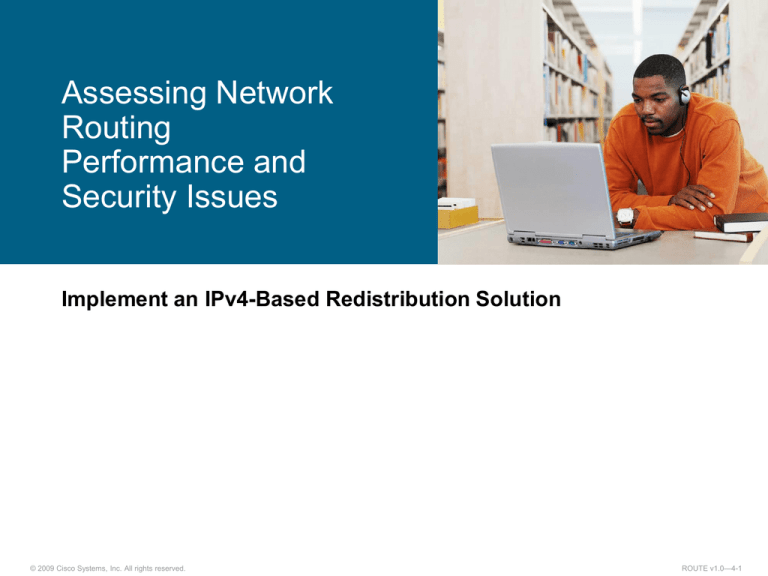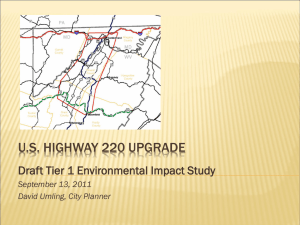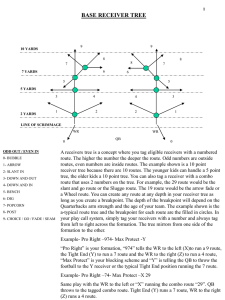
Assessing Network
Routing
Performance and
Security Issues
Implement an IPv4-Based Redistribution Solution
© 2009 Cisco Systems, Inc. All rights reserved.
ROUTE v1.0—4-1
Common Factors Affecting Network
Performance
Routing factors that influence CPU utilization include:
– The size of the routing information update
– The frequency of the updates
– The weaknesses in the design
– The presence of any route maps or filters
Incorrectly configured route filters
Running different protocols in different areas within the same
autonomous system
– The number of routing protocol processes receiving the
updates
© 2009 Cisco Systems, Inc. All rights reserved.
ROUTE v1.0—4-2
Routing Updates
Qualities of routing updates that influence CPU utilization include:
– The size of the routing information update
– The frequency of the updates
– A bad design
© 2009 Cisco Systems, Inc. All rights reserved.
ROUTE v1.0—4-3
Filtering Routing Updates
Routing update filters may improve network performance
Ensure router filters are configured correctly
© 2009 Cisco Systems, Inc. All rights reserved.
ROUTE v1.0—4-4
Running Multiple Routing Protocols
You can run different protocols in different areas within
the same autonomous system.
– If many routing protocol processes receive updates at the
same time, performance will be affected.
© 2009 Cisco Systems, Inc. All rights reserved.
ROUTE v1.0—4-5
Controlling Routing Updates
Design change
– Limit the number of routing protocols used
Passive interfaces
Redistribution with route filtering
– Access lists
– Prefix lists
– Distribute lists
– Route maps
© 2009 Cisco Systems, Inc. All rights reserved.
ROUTE v1.0—4-6
Using Route Filters
A neighbor relationship is established
Adjacent routes exchange routing updates
– The process takes effect after multiple stages have been
completed
© 2009 Cisco Systems, Inc. All rights reserved.
ROUTE v1.0—4-7
Controlling Routing Update Traffic Using
Distribute Lists
© 2009 Cisco Systems, Inc. All rights reserved.
ROUTE v1.0—4-8
Steps to Configure Distribute List Filters
Define the traffic filtering requirements to permit or deny routes
using one of these two methods:
– Configure an access list (ACL)
– Configure a route map
Configure a distribute list to use the ACL or a route map:
– Apply it to the inbound or outbound updates
© 2009 Cisco Systems, Inc. All rights reserved.
ROUTE v1.0—4-9
Configuring a Distribute List Filter
A distribute list filter can be applied to transmitted, received, or
redistributed routing updates.
R1(config)#
router rip
redistribute ospf 1 metric 5
distribute-list 10 out OSPF 1
Filtering of updates being advertised from OSPF into RIP routing
protocol according to access list 10
R1(config)#
router EIGRP 100
distribute-list 7 in Serial0
Filtering of networks received in updates from interface Serial0
according to access list 7
© 2009 Cisco Systems, Inc. All rights reserved.
ROUTE v1.0—4-10
Filtering Routing Updates with a
Distribute List
Hides network 10.0.0.0 using interface filtering
© 2009 Cisco Systems, Inc. All rights reserved.
ROUTE v1.0—4-11
Controlling Redistribution with
Distribute Lists
© 2009 Cisco Systems, Inc. All rights reserved.
ROUTE v1.0—4-12
IP Prefix Filters
Traditionally, IP prefix filters were implemented with IP access
lists configured with the distribute-list command.
Prefix lists:
– Better performance than access lists
– User-friendly command-line interface
– Match routes in part of an address space with a subnet mask
longer or shorter than a set number
© 2009 Cisco Systems, Inc. All rights reserved.
ROUTE v1.0—4-13
Controlling Redistribution with
Prefix Lists
© 2009 Cisco Systems, Inc. All rights reserved.
ROUTE v1.0—4-14
Prefix List Matching Rules
Filter by exact prefix length
– mask filtering “/”
Filter within a range
– using ge
– using le
– using ge and le
The matching process also considers the subnet mask
© 2009 Cisco Systems, Inc. All rights reserved.
ROUTE v1.0—4-15
Prefix List Matching Without ge or le
Similar to IP access lists with no wildcard bits
R2(config)#
ip prefix-list MyMatchList permit 192.168.0.0/16
Which prefixes are matched?
– 192.168.0.0/16: Match
– 192.168.0.0/20: No Match
– 192.168.2.0/24: No Match
© 2009 Cisco Systems, Inc. All rights reserved.
ROUTE v1.0—4-16
Prefix List Matching With ge or le
A prefix list entry with the ge or le keyword matches any prefix
within a specified address space for which the subnet mask falls
within the specified limits.
R2(config)#
ip prefix-list List1 permit 192.168.0.0/16 le 20
ip prefix-list List2 permit 192.168.0.0/16 ge 18
Which prefixes are matched?
– 192.168.0.0/16, List1: Match
– 192.168.0.0/16, List2: No Match
© 2009 Cisco Systems, Inc. All rights reserved.
ROUTE v1.0—4-17
Configuring Prefix Lists Examples
What will be matched by?
1. ip prefix-list A permit 0.0.0.0/0 ge 32
2. ip prefix-list B permit 128.0.0.0/2 ge 17
3. ip prefix-list C permit 0.0.0.0/0 le 32
4. ip prefix-list D permit 0.0.0.0/0
5. ip prefix-list E permit 0.0.0.0/1 le 24
© 2009 Cisco Systems, Inc. All rights reserved.
ROUTE v1.0—4-18
Configuring Prefix Lists Examples
(Cont.)
What will be matched by?
1. ip prefix-list A permit 0.0.0.0/0 ge 32
2. ip prefix-list B permit 128.0.0.0/2 ge 17
3. ip prefix-list C permit 0.0.0.0/0 le 32
4. ip prefix-list D permit 0.0.0.0/0
5. ip prefix-list E permit 0.0.0.0/1 le 24
All host routes
1. Any subnet in a class B address space
2. All routes
3. Just the default route
4. Any prefix in a class A address space covering at least 256
addresses
© 2009 Cisco Systems, Inc. All rights reserved.
ROUTE v1.0—4-19
Route Maps
Route maps are similar to a scripting language for these reasons:
– They work like access lists, but are more sophisticated.
They offer top-down processing.
When one of them finds a match, it stops searching.
– Lines are sequence-numbered for easier editing.
Insertion of lines
Deletion of lines
– Route maps are named, rather than numbered, for easier
documentation.
– Match criteria and set criteria can be used; similar to the if-then
logic in in scripting languages.
© 2009 Cisco Systems, Inc. All rights reserved.
ROUTE v1.0—4-20
Route Map Applications
The common uses of route maps are as follows:
Redistribution route filtering
– a more sophisticated alternative to distribute lists
Policy-based routing
– the ability to determine a routing policy based on criteria other
than the destination network
BGP policy implementation
– the primary tool for defining BGP routing policies
© 2009 Cisco Systems, Inc. All rights reserved.
ROUTE v1.0—4-21
Route Map Operation
A list of statements constitutes a route map.
The list is processed in a top-down manner, like access lists are.
The first match found for a route is applied.
The sequence number is used for inserting or deleting specific
route map statements.
route-map MyRouteMap permit 10
{ match statements }
{ match statements }
{ set statements }
{ set statements }
route-map MyRouteMap deny 20
::
::
::
::
::
::
route-map MyRouteMap permit 30
::
::
::
::
::
::
© 2009 Cisco Systems, Inc. All rights reserved.
ROUTE v1.0—4-22
Route Map Operation (Cont.)
The match statement may contain multiple references.
Multiple match criteria in the same line: logical OR.
At least one reference must permit the route for it to be a
candidate for redistribution.
route-map MyRouteMap permit 10
match ip address ACL1 ACL2 ALC3
Logical OR
route-map MyRouteMap deny 20
match ACL1
match interface fastethernet0/0
match metric 3
Logical AND
Multiple match statements on separate lines: logical AND.
All match statements must permit the route for it to remain a
candidate for redistribution.
Route map permit or deny statements determine if the candidate
will be redistributed.
© 2009 Cisco Systems, Inc. All rights reserved.
ROUTE v1.0—4-23
Steps to Configure A Route Map
Define the route map conditions
– Define the conditions to match
– Define the action to be taken on a match
Attach the route map to an interface
© 2009 Cisco Systems, Inc. All rights reserved.
ROUTE v1.0—4-24
Configuring A Route Map
R1(config)#
route-map MyRouteMap permit 10
Defines the route map with the name MyRouteMap conditions.
R1(config-route-map)#
match ip address prefix-list MyList
Matches based on the prefix list “MyList” when defining the
conditions to match.
R1(config-route-map)#
set interface ethernet 0
Defines that interface ethernet 0 be used to forward packets that
pass a match clause.
© 2009 Cisco Systems, Inc. All rights reserved.
ROUTE v1.0—4-25
Attaching a Route Map to an Interface
R1(config-if)#
ip policy route-map MyRouteMap
Defines a route map named “MyRouteMap” to be used for policy
routing on an interface.
R1#
interface serial 0
ip policy route-map MyRouteMap
!
route-map MyRouteMap
match ip address 172.21.16.18
set metric 3
Set the metric to 3 if the route is from IP address 172.21.16.18.
© 2009 Cisco Systems, Inc. All rights reserved.
ROUTE v1.0—4-26
Steps to Configure Redistribution with
Route Maps
Define the route map
– Define match statements
– Define set statements
Define redistribution using the route map
© 2009 Cisco Systems, Inc. All rights reserved.
ROUTE v1.0—4-27
Route Map Redistribution Commands
R1#
route-map rip_to_eigrp deny 10
match tag 88
route-map rip_to_eigrp permit 20
set tag 77
Define the route map used during redistribution.
R1(config)#
router eigrp 7
redistribute rip route-map rip_to_eigrp metric 1 1 1 1 1
Configure redistribution from RIP to the EIGRP routing protocol
using the route map to filter updates.
© 2009 Cisco Systems, Inc. All rights reserved.
ROUTE v1.0—4-28
Route Maps and Redistribution
Commands Example
R1#
router ospf 10
redistribute rip route-map
redisRIP
!
Route-map redisRIP permit 10
match ip address 23 29
set metric 500
set metric-type type-1
route-map redisRIP deny 20
match ip address 37
route-map redisRIP permit 30
set metric 5000
set metric-type type-2
!
access-list 23 permit 10.1.0.0 0.0.255.255
access-list 29 permit 172.16.1.0 0.0.0.255
access-list 37 permit 10.0.0.0 0.255.255.255
Routes matching either access list 23 or 29 are redistributed with
an OSPF cost of 500, external type 1.
Routes permitted by access list 37 are not redistributed.
All other routes are redistributed with an OSPF cost metric of
5000, external type 2.
© 2009 Cisco Systems, Inc. All rights reserved.
ROUTE v1.0—4-29
Filtering Routing Updates
© 2009 Cisco Systems, Inc. All rights reserved.
ROUTE v1.0—4-30
Passive Interface
Routers can have many interfaces
– Not all are allowed to send and receive routing updates
The suppression of routing updates over some interfaces can be
enabled
Passive interfaces are used to:
– Suppress updates on an interface
– Suppress updates on all interfaces
Each routing protocol has different rules
– OSPF: routing information is neither sent nor received
– EIGRP: routing process is disabled on an interface
– RIP: the sending of updates is disabled, but listening is allowed
© 2009 Cisco Systems, Inc. All rights reserved.
ROUTE v1.0—4-31
Using the passive-interface Command
© 2009 Cisco Systems, Inc. All rights reserved.
ROUTE v1.0—4-32
Summary
Sending an excessive number of routing updates, running
different protocols in different areas within the same autonomous
system, and incorrectly configuring route filters are common
causes of network performance issues.
Distribution lists use access lists or route maps to define the traffic
filtering requirements to permit or deny routes.
The distribute-list command allows updates to be filtered based
on the incoming interface, outgoing interface, or redistribution
from another routing protocol.
Prefix lists significantly improve the performance of complex filters
relative to traditional IP prefix filters implemented with IP access
lists.
The matching process for prefix lists takes into account the subnet
mask. A filter can be configured for the exact prefix length, or it
can be configured within a range using the ge and le keywords.
© 2009 Cisco Systems, Inc. All rights reserved.
ROUTE v1.0—4-33
Summary (Cont.)
Route maps are complex ACLs that allow conditions to be tested
against a packet or route using the match command. If the
conditions match, then actions, specified by the set command,
can be taken to modify the attributes of the packet or route.
When used for redistribution filtering, a route map is applied to the
route redistribution process by adding the route-map command to
the end of the redistribute routing protocol command.
When route maps are used to filter routing update traffic, they can
be applied to incoming or outgoing traffic. The routes that are
permitted can have their attributes set or changed by the set
command in the route map.
A passive interface can be configured to suppress updates on a
specific interface or on all interfaces.
© 2009 Cisco Systems, Inc. All rights reserved.
ROUTE v1.0—4-34
© 2009 Cisco Systems, Inc. All rights reserved.
ROUTE v1.0—4-35







